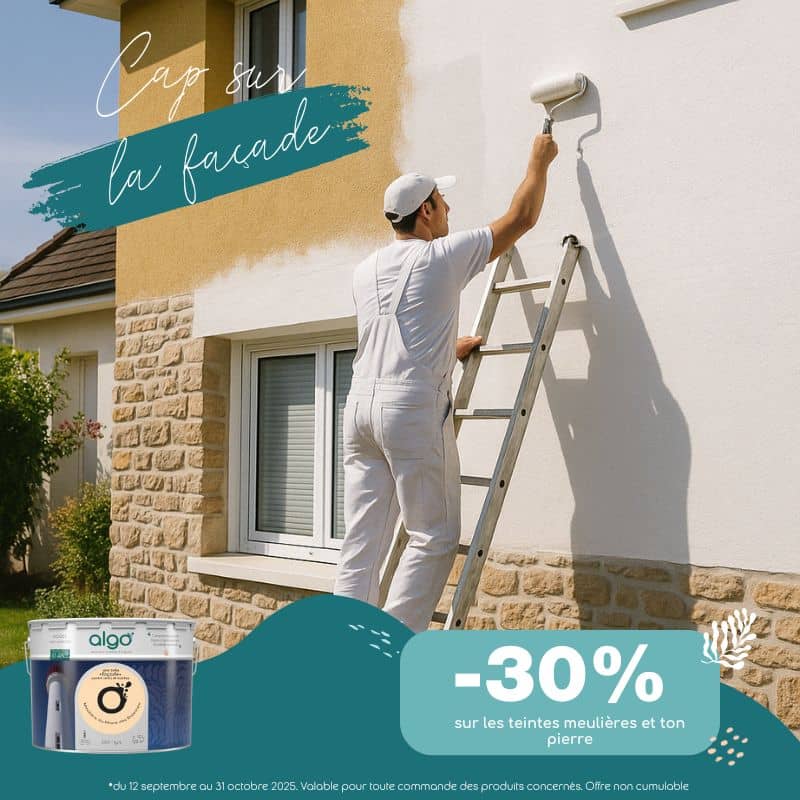In addition to being very diverse and trendy, Algo paints have the advantage of being ecological, thanks to a formulation that emits less than 1g/liter of Volatile Organic Compounds, respecting both the environment and your health.
Credible by the A+ pictogram and by the European Ecolabel standard, Algo therefore offers a real solution to classic paints.
What are VOCs?
Volatile Organic Compounds, more commonly known as VOCs, are volatile chemicals that contain carbon and thus release emissions. They can be naturally occurring or linked to human activity, as is the case with acetone or ethanol. Highly volatile, VOCs escape from many everyday products such as household cleaners, cosmetics, or paint cans, polluting our environment.
The consequences of high VOC levels for ecology
The impact of VOCs is visible on two levels. First, on a global level, VOCs have harmful consequences for the environment, as they increase the concentration of ozone in the atmosphere, thus contributing to the amplification of greenhouse gas emissions. At the same time, they contribute to water pollution through air and soil contamination, and are thus dangerous for all animal and plant species.
The health consequences of VOCs
In addition to these very worrying impacts on our planet, VOCs are also very dangerous for our health, especially formaldehyde. They are considered a carcinogenic toxic substance and are known, among other things, to cause sore throats, disrupt sleep, and promote migraines, coughs, and asthma. They can also cause eczema as well as digestive and kidney problems. These risks are even higher when these substances are released into the rooms of our homes, increasing the risk of degrading our health by contaminating the air quality in our homes.
It is important to choose an ecological paint for your interior
Paints are a particularly high source of VOC emissions, especially when they contain colorants or simply solvents or co-solvents. VOCs are released into the air during application and drying, which can cause effects ranging from simple discomfort caused by the odor to much more serious respiratory problems. These consequences vary mainly depending on the concentration of VOCs inhaled following application and the duration of exposure. Due to its application in enclosed spaces, frequented daily, paint can be particularly harmful, especially for young children.
While synthetic paints, and more specifically acrylic paints, are among the paints singled out for their high VOC content, water-based paints are also paints that should be closely monitored in this regard.
Our guide to choosing the most natural, solvent-free eco-friendly paint
Choosing the perfect, VOC-free paint for your project is no easy task. First and foremost, it's important to choose a paint that's certified with the A+ symbol found on most paint cans, as well as a paint that carries a label.
This pictogram, which must be displayed on paint pots, makes it possible to establish a classification between products in terms of emissions into indoor air , even if this may be insufficient.
In fact, the A+ standard is open to all paints emitting less than 1,000 µg/m³ twenty-eight days after application, which is ultimately not so restrictive for manufacturers of natural paints.
This is why Algo has taken care to develop eco-friendly paints that, in addition to being organic and made from natural raw materials, emit a low VOC content of less than 1 g/liter. This quantity of VOCs is, moreover, well below what is recommended by European regulations, which have imposed a rate of less than 30 g/liter since 2010. Therefore, choosing Algo paints means protecting the environment and your loved ones.
All of this information can be found on our technical sheets
Useful precautions:
However, to take the maximum precautions possible, we recommend that you thoroughly ventilate all rooms in your home throughout the work and thoroughly wash all rollers and brushes. It is also strongly recommended that you continue to ventilate your home daily to minimize the concentration of VOCs in the air.








